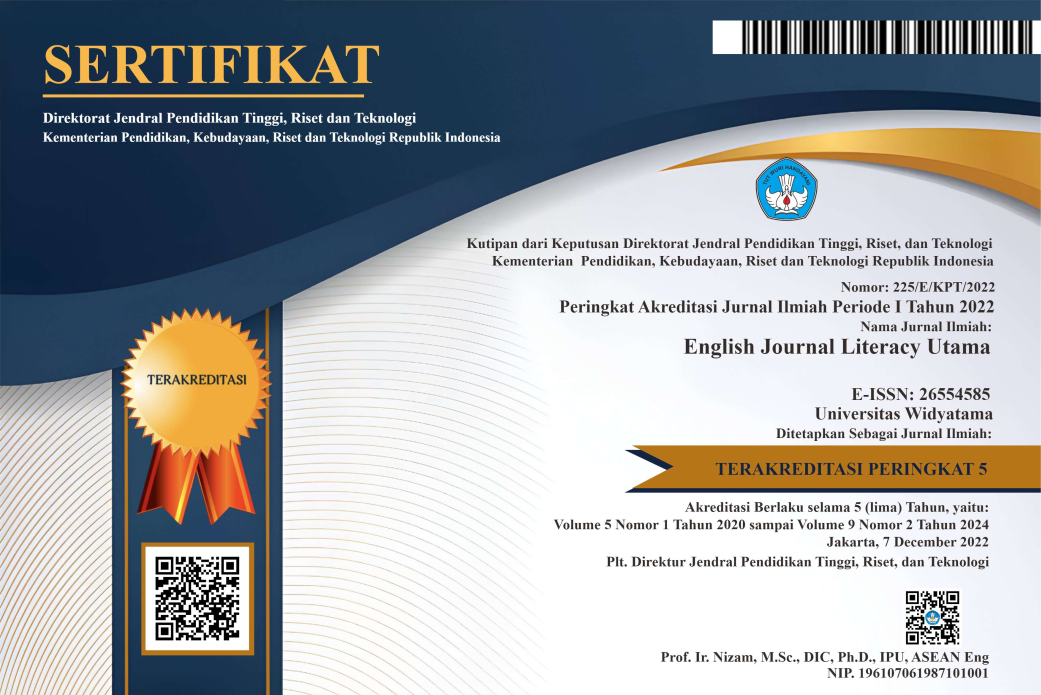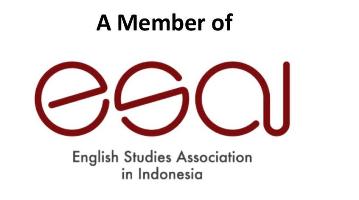UTILIZING THE FLIPPED LEARNING TO PROMOTE EFL STUDENT’S ENGAGEMENT; A PRELIMINARY STUDY
DOI:
https://doi.org/10.33197/ejlutama.v7i2.206Kata Kunci:
Flipped learning, student’s Engagement, In-class session, Out-class session, student’s engagementAbstrak
Flipped learning (FL) has been a popular approach for it’s potential in promoting student’s engagement in EFL context particularly. Although it is considered applicable in higher and K-12 education, researches in the latter category are still scarce, especially that reported its implementation in detail. This preliminary action research is involving 14 secondary school students. It focuses on how utilizing FL engage EFL student in learning and what challenges teacher faces during the implementation. Findings indicate that FL implementation combined with teacher’s approach has not yet promoted student’s engagement in learning English. During in-class session, even though the students participated in playing board game in a speaking activity, only few of them kept practicing enthusiastically. Student’s commitment for outclass activities as instructed by the teacher and task completion were still low. The problems identified were that students got less frequent mobile device use after school and their minimum parent’s support. Further action plans are recommended for the follow-up research.
Referensi
Anwar, C. (2017). Flipped Classroom in Teaching Vocabulary to EFL Young Learners. August 1945, 109–115. https://doi.org/10.24176/03.3201.13
Baker, W. (2000). “The” classroom flip: “Using web course management tools to become the guide by the side”. In 11th international conference on college teaching and learning (pp. 9–17).
Bergmann, J., & Sams, A. (2012). Flip your classroom: reach every student in every class every day. In L. Gansel & T. Wells (Eds.), Washington, DC: United States of America: International Society for Technology in Education (ISTE).
Bergmann, J., Overmyer, J., & Wilie, B. (2013). The flipped class: Myths vs. reality. The Daily Riff. Retrieved from http://www.thedailyriff.com/articles/the-flipped-class-conversation-689.php.
Betaubun, M. (2021). The Students’ Attitude and Learning Experience toward Flipped Classroom Implementation in ESP Class During COVID-19 Outbreak: A Survey Study. Jurnal Pendidikan Progresif, 11(1), 54–62. https://doi.org/10.23960/jpp.v11.i1.202105
Burns, Anna. 1999. Collaborative Action Research for English Language Teacher. United Kingdom: Cambridge University Press
DeYoung, A. J., & Lawrence, B. K. (1995). On Hoosiers, Yankees and Mountaineers. ERIC Document Reproduction Service No. ED 383-508
Ellis, N.C. (2019). Essential of a theory of language cognition. The Modern Language Journal, 103, 39-60
Gough, E., DeJong, D., Grundmeyer, T., & Baron, M. (2017). K-12 Teacher Perceptions Regarding the Flipped Classroom Model for Teaching and Learning. Journal of Educational Technology Systems, 45(3), 390–423. https://doi.org/10.1177/0047239516658444
Hiver, P., Al-Hoorie, A. H., Vitta, J. P., & Wu, J. (2021). Engagement in language learning: A systematic review of 20 years of research methods and definitions. Language Teaching Research. https://doi.org/10.1177/13621688211001289
Julinar, J., & Yusuf, F. N. (2019). Flipped Learning Model: Satu Cara Alternatif untuk Meningkatkan Keterampilan Berbicara Siswa. Jurnal Penelitian Pendidikan, 19(3), 366–373. https://doi.org/10.17509/jpp.v19i3.22330
Jun Scott Chen Hsieh. Vivian Wu, Wen-Chi, & Marek, Michael W. 2017. Using the Flipped learning to Enhance EFL Learning, Computer Assisted Language Learning. Routledge: Taylor and Francis Group
Mandasari, B., & Wahyudin, A. Y. (2019). Flipped Classroom Learning Model: Implementation and Its Impact on EFL Learners’ Satisfaction on Grammar Class. Ethical Lingua, 8(1), 2021.
Ramey, Kay E et al. 2016. Qualitative Analysis of Video Data: Standards and Heuristics.
Reflianto, Setyosari, P., Kuswandi, D., & Widiati, U. (2022). English teachers’ competency in flipped learning: Question level and questioning strategy in reading comprehension. International Journal of Instruction, 15(1), 965–984. https://doi.org/10.29333/iji.2022.15155a
Tapscott, D. (2010). Grown up digital: How the Net generation is changing your world. International Journal of Market Research, 52(1), 139–140.
Tragant, Elsa & Vallbona, Anna. (2018) Reading while listening to learn: young EFL learners’ perceptions, ELT Journal, Volume 72 Pages 395–404, https://doi.org/10.1093/elt/ccy009
Wigfield, A. (1997). Reading engagement: a rationale for theory and teaching. In J.T. Guthrie and A. Wigfield (Eds.), Reading Engagement: Motivating Readers Through Integrated Instruction. Newark, DE: International Reading Association.
Zainuddin, Z., Shujahat, M., Haruna, H., & Chu, S. K. W. (2020). The role of gamified e-quizzes on student learning and engagement: An interactive gamification solution for a formative assessment system. Computers and Education, 145, 103729. https://doi.org/10.1016/j.compedu.2019.103729
Zamzami Zainuddin. (2017). First-Year College Students’ Experiences in the EFL Flipped Classroom: A Case Study in Indonesia. International Journal of Instruction, 10(1), 133–150. http://www.e-iji.net/dosyalar/iji_2017_1_9.pdf
Unduhan
Diterbitkan
Terbitan
Bagian
Lisensi
Hak Cipta (c) 2023 Silvina Yuza, Fazri Nur Yusuf

Artikel ini berlisensiCreative Commons Attribution-NonCommercial-ShareAlike 4.0 International License.
Creative Commons Attribution-ShareAlike 4.0 International License















